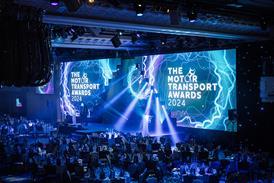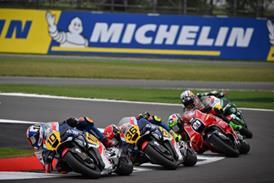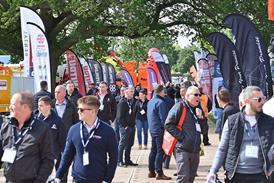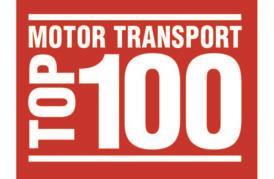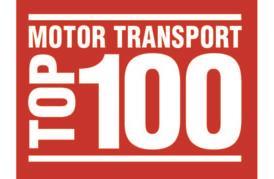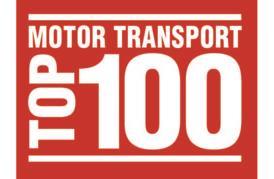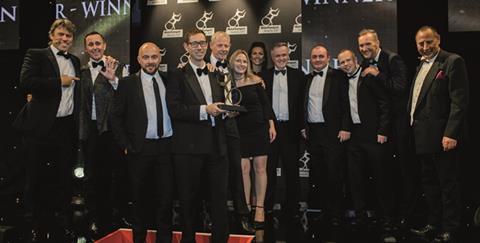
Hermes bagged the Operational and Compliance Excellence award for its client and compliance-focused technology.
Hermes continues to expand at an exceptional pace. During 2017 the company will process 300 million parcels through its network – a 15% increase on 2016. On anygiven day, the consumer delivery specialist handles upwards of 850,000 parcels, rising to 1.5 million during peak periods. Its busiest day of the year, which falls three days after Black Friday, sees 1.8 million parcels pass
through the network.
The network itself comprises three major sortation hubs in Warrington, Nuneaton and a new £31m fully automated site in Rugby, which opened in August. These hubs receive 1,800 collections a week, which are sorted and dispatched to 26 national depots through 300 trunking movements a night. From here, the depots send the parcels to 565 sub-depots where they are picked up by local couriers for last mile deliveries.
With the sheer volume of parcels being processed, it is vital for Hermes to ensure its network runs as efficiently as possible, which is where the operational team rises to the challenge. Led by Jon Ormond, director of hub and depot operations, the team oversees the smooth running of the firm’s sites, equipment and transport. But more than that, the team strives to keep the customer experience at its core, ensuring the technology behind the scenes continues to advance the service received by its retail clients and their end customers.
“My team is client-focused at all times,” said Ormond. “We’re linked to the entire operation and develop new products to support and provide opportunities for our client managers and the final mile.”
The company’s new STAR (seamless, trackable, auditable return) system is an example of how the team has worked to develop technology to enhance the customer experience. Currently in trials, the system gives customers a file that can track a returned product from the doorstep back to a depot.
“The client will get a file and the final point will be when we break the geofence at their site – it will be fully traceable,” says Ormond. “There is plenty of room within the industry to improve returns, and we will be leading with this when we go live in February next year.”
Technology drive
Hermes has invested in new technology over the past few years to drive efficiencies from shunting trailers in the yard to deliveries at the doorstep. One investment that has paid dividends is the introduction of Isotrak telematics to improve tracking and visibility of the transport operation.
Planners are able to see in real time how each driver, vehicle and schedule is progressing and can react instantly to an unexpected activity to keep deliveries on time.
First introduced in 2013, it was originally installed to manage fuel more efficiently.
“However, what we really use it for now is driver behaviour, such as over-revving and harsh braking. This has proved much more beneficial,” said Ormond. “It’s taken our mpg at 26 depots from between
12mpg and 15mpg to 18mpg and on tractors from 10mpg to 12mpg to 14mpg in some cases – which is industry-leading for Class 1 vehicles and for 12-tonners to be near 18mpg is excellent.”
Overall, the company has seen a 22% improvement in mpg across the fleet. Driver behaviour scores have also improved through telematics: the company set itself a target of 85, with more than 60% of drivers already scoring higher than this.
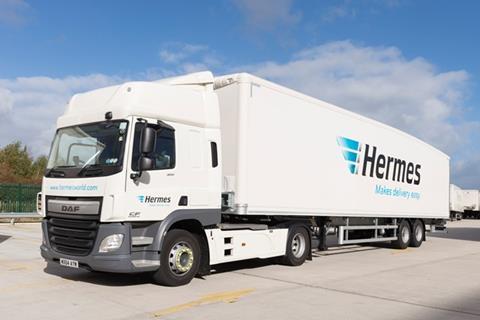
To complement Isotrak, Hermes uses Ortec route optimisation software to help it plan fleet movements. The firm’s routeing of collections used to be done manually through local knowledge at depots, but the Ortec system has significantly improved fleet efficiencies. For example at depot level, whereas single stem routes were previously operated directly to a client, Hermes combines routes, uses multi-collection points and reverse trunking. “It’s saved us 7% by more efficient planning,” said Ormond.
The system is linked into Hermes’ new yard management system, provided by DAI. Trailers are prioritised remotely, overseen by a control room at Rugby, with geofencing technology used when they reach a site to enable them to be positioned correctly.
“When we collect from clients, we know the date, what’s on board and the date it needs to be processed,” he said. “So when it comes onto site, the trailer is scanned,positioned in the yard and the tug team are
informed when it needs to be processed.”
A traffic light system is used to make sure all timescales are met. The system went live earlier this year.
“When you have up to 2,000 trailers at peak, we need this for our clients,” said Ormond. “Particularly as our extended next-day service accepts parcels up to 2am for processing that day.”
In-cab focus
Health and safety and reducing road risk is a key focus for Ormond’s team. For example, safety system Lytx has proven to be a success across its fleet, helping to drive down the company’s claims bill, while providing protection for drivers in the event of a non-fault road collision.
An in-cab camera records in the event of any incidents, such as an impact or harsh braking. An alert goes to Lytx, which sends Hermes a report on what happened. “It’s about team learning,” said Ormond. “It’s a gradual assessment for drivers. If something goes wrong, they get training first.”
He added: “We are starting to see a reduction in our damages of 20%. The average in the network is something like 75p-per-mile and we’re about 60p-per-mile. This has improved by using the combination of Isotrak and Lytx.”
However, the cameras are also used for positive driver feedback, said Ormond. For example, if an HGV braked sharply due to a pedestrian or cyclist not looking where they were going, but the driver’s actions prevented a collision, this would allow Hermes to reward the driver for best-practice driving behaviour.
“First and foremost we brought this in to increase the safety of other road users and be responsible; second to proactively train and praise our drivers; and third, to mitigate against ourselves and our drivers being victims of insurance scams,” said Ormond.
Audit shake-up
Hermes has also shaken up its auditing to allow a more thorough approach for its transport division. Instead of combining health and safety with transport, Hermes took the decision to split the two areas, to enable more detailed, frequent audits to take place.
Health and safety became the focus for Hermes’ HR Service division, which meant the operations team had more time to devote to transport.
Audit frequency was taken from quarterly to monthly, with new responsibilities given to the inbound manager at depots to put them in charge of transport compliance and regulations, as well as dealing with the vehicles and drivers.
“We have increased our [transport] CPC licence holders from one to three at each site and have an inbound and outbound manager with a CPC as well as a depot manager,” said Ormond. “It wasn’t mandatory, but we wanted to do it and it was recommended by the traffic commissioner.”
As a result, Hermes has improved its internal auditing score from 90% to 95%. The company is also exploring FORS.
“We haven’t yet rolled this out, but are looking into it,” said Ormond. “We want to be recognised by FORS and we are aiming for gold status.”
So what made Hermes’ operational team stand out from the crowd for this year’s MT Awards judges?
Ormond attributes the team’s success to Hermes’ culture of making the customer experience the focus of every individual throughout the organisation.
“It’s not just about compliance, but about the emotive element of ‘what’s inside the box’,” he said. “It’s a progressive company to work for and we want all employees to buy into how important the customer is.”
For the customer, the whole delivery experience can be emotive, from the initial ordering through to tracking its progress to their door. “We want everyone to understand this feeling, as they are consumers themselves.”
Hermes’ own customers’ success and their “phenomenal growth” have also helped the business to flourish.
“We have a foundation of fantastic retailers who are successful and we understand what they require,” says Ormond. “We keep pace with them by investing in our hubs, technology and our vehicles to support that growth. It’s this partnership with our clients that has given us the chance to excel.”
FLEET ON THE MOVE
Hermes’ fleet comprises 150 tractor units for trunking, 350 depot-based trucks between 12 and 18 tonnes, and 1,047 trailers, all leased from Ryder. Trucks are predominantly DAF and trailers mostly supplied by Cartwright, with a small cohort of Tiger Trailers.
It is always looking to drive efficiencies through fleet innovation. For example, it is exploring Cartwright’s side-loading, urban Streetwise trailers as a potential parcel pick-up point for couriers. “It would be a mini sub-depot where we can’t find property in city centres,” said Ormond. “We would need to get agreements with councils so couriers can come and collect their parcels.”
Hermes has also been looking at new vehicles emerging to market, such as the Arrival electric truck, and is trialling Mitsubishi Fuso Canter Hybrid (electric/diesel) trucks at its Weybridge and Enfield depots.
It already partners with electric van operator Gnewt Cargo in London for zero-emission last-mile deliveries, while trialling a small amount of Starship Technologies’ self-driving delivery robots for timeslot collections.




